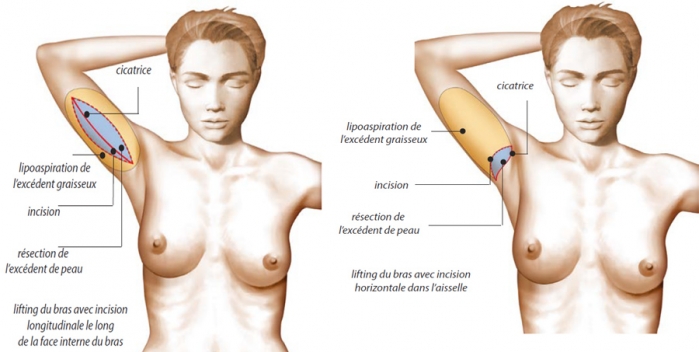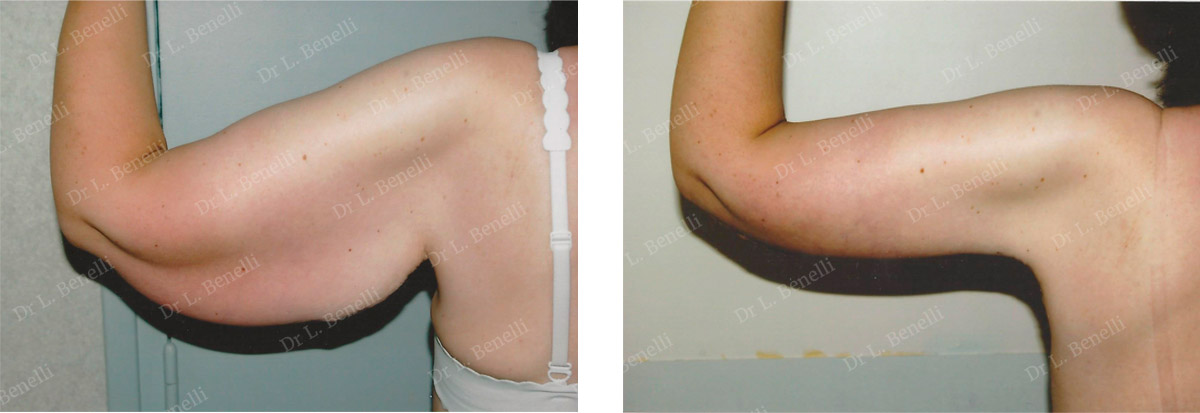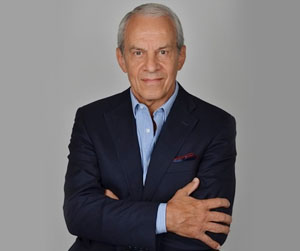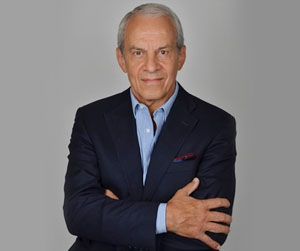Arm lift
The arm lift is intended for patients whose arms are sagging with a significant excess of cutaneous fat, usually after significant weight variations.
The aim of the operation is to tighten the skin and refine the shape of the arms by removing excess skin and fat.
Excess skin is usually removed from the inner and posterior part of the arms, with the length of the scar depending on the extent of the sagging:
-
A simple horizontal scar is limited to the axillary fold (armpit) for a moderate excess;
-
A vertical scar starts from the axillary fold and descends along the posterior internal side of the arm.

There are two ways to remove excess fat:
-
Fat is removed from under the skin in one block;
-
The fatty excess is removed by liposuction even outside the area of skin resection.
When sagging is really significant, it is a source of discomfort in daily life (bouncing, discomfort when moving, difficulty wearing certain clothes, etc.).

Arm lift after massive weight loss, scar located under the arm between the elbow and the armpit, with liposuction.
Uses
There are different types of arm lift depending on the severity of the anatomical problems.
A simple excess of fat can be treated by liposuction.
Moderate upper arm sagging can be treated by an arm lift with an axillary scar (armpit) and combined liposuction to reshape the entire arm, while the skin is tightened over the axillary scar.
Significant skin sagging over the entire arm will require a larger scar, extending from the axillary fold (armpit) to the inner surface of the arm and descending as far down as necessary, depending on the amount of excess skin.

Arm lift after massive weight loss, scar located under the arm between the elbow and the armpit, with liposuction
Each person arrives with a request for correction of a particular defect that is particularly troublesome to them. The objective of the operation will be to correct this defect as a priority by assessing whether it may be appropriate to correct other associated defects to have a well-balanced, natural result that meets expectations.
So, depending on the insights gained during the first consultation, the operation could possibly be combined with another procedure, notably liposuction, abdominoplasty, a thigh lift, a facelift, breast lift, or breast augmentation using either prosthetics or by lipofilling (injecting your own fatty tissue collected during the abdominoplasty). This can be carried out during the same operation or at another time, depending on the associated operation.
Consultation
During the first consultation, it is essential that you openly express what bothers you and what you would like to improve. Do not be afraid to ask any questions, including expressing your fears and expectations. Everyone has a different body shape, psychology and expectations. These are not the same and there is no standard to apply.
After you have explained your motivations, I will examine you and propose one or more solutions, taking into account your expectations, your anatomy, respecting your identity and the natural aspect of your appearance.
During the first consultation, I will evaluate the technique to use, the location and extent of scars, areas to treat with liposuction and, if necessary, by lipofilling.
In order for you to visualise the desired result, I will show you photos of surgical results from cases similar to yours so you can understand the objective of the procedure.
It is essential that you and I have a good understanding when deciding to operate and to determine the technique to use from among those I can suggest.
I will then give you all the information on the techniques proposed along with the information sheets from the Société Française de Chirurgie Plastique Reconstructrice et Esthétique (French Society of Plastic, Reconstructive and Cosmetic Surgery) as well as a detailed estimate of the costs for the options chosen. You will then be able to progress your project and get ready for a second consultation when you will be able to ask any additional questions to help you make a decision and prepare for the operation.
Before the procedure
A full or partial blood test will be needed, depending on the type of anaesthetic (local or general).
In the event of a general anaesthetic, you will need a consultation with the anaesthetist in the weeks leading up to the operation and at least 48 hours before.
Underarm waxing is necessary a few days before the procedure.
You will be prescribed a specific post-operative support sleeve to buy and will need to bring this with you on the day of the operation so it can be worn at the end of the operation.
Recommendations:
No medications containing aspirin or anti-inflammatories can be taken within 10 days of the procedure.
If you are having a general anaesthetic, you must fast strictly for 6 hours before the operation (do not eat anything, chew gum, eat sweets, or smoke).
Tobacco consumption should be stopped or reduced as much as possible during the month before and month after the procedure. Tobacco can cause scarring problems.
The procedure
Hospitalisation and the duration of the procedure:
Your stay in hospital is usually limited to half a day in a day clinic. An overnight stay in hospital may sometimes be necessary depending on the scale of the operation.
The procedure lasts about 1.5 hours.
Type of anaesthesia:
Local, deep local (neuroleptanalgesia) or general, depending on patient preference.
Technique:
Before you go to the operating theatre, in your room, I will go over the precise goals with you as we agreed during the consultations. You can then always make recommendations and ask any questions. I will then draw the lines and marks on your skin to guide the operation and the lines of the incisions.
For moderate sagging, a horizontal incision is made in the axillary fold (armpit).
The tissue under the area of skin resection is placed over the axillary scar. These tissues are deeply anchored within the armpit to avoid any skin tension that could lead to a subsequently larger scar.
If the excess cutaneous fat is spread over the entire arm, the scar will be vertical rather than horizontal and located along the posterior internal face of the arm so it is as discrete as possible, starting from the axillary fold and descending as far down as needed, depending on the size of the area of excess skin.
To finalise the reshaping, liposuction is used to remove any residual fatty excesses, especially around the armpit and in the back.
The stitches are placed within the skin’s thickness (inverted and intradermal stitches), which means they are invisible. These stitches are also absorbable, which means they do not need to be removed. Staples are sometimes used to complete the internal stitch, if necessary.
At the end of the operation, a compression bandage is applied to the scar and a special sleeve is used as a post-operative restraint.
After the operation
During the night and the days following the operation, there may be a painful sensation of tension in the area that was operated on such as aches and pains, which may impede your mobility. These pains are moderate in a resting position and may require analgesics that are given by a drip during your stay in hospital or are taken as tablets at home. These post-operative pains will diminish and disappear within a few days of the operation.
You can resume most normal activities the day after the operation using your arms and body. However, lifting your arms up high can be painful.
Swelling (oedema) and bruising are generally moderate and it takes about ten days for these to disappear almost completely.
As the stitches used are absorbable, they do not need to be removed. As they are placed internally within the skin’s thickness (intradermal stitches), they are invisible. Any staples are removed within a week of the operation to avoid leaving a mark.
You will need to take time off work for about a week if your job requires you to exert yourself using your arms. For jobs where there is no particular arm effort, you could go back to work the day after the operation.
Care:
-
The sleeve should be worn day and night for one week.
-
The scars should be cleaned with an antiseptic following a shower and, if necessary, treated with ointment in the weeks and months following the operation to improve the quality of healing.
You will need to attend a follow-up consultation about a week after the procedure, then after 1 month, 3 months, 6 months, and 1 year.
Recommendations:
-
You may resume sporting activities as soon as any painful discomfort has subsided.
-
Limit your range of arm movements according to the pain you are experiencing and do not force any movements if you are feeling any painful discomfort. Most of the time, everyday arm movements do not present a problem.
-
Exposure to the sun: No exposure while there are traces of bruising, even if these are small. Then, exposure is allowed using a sunscreen with a maximum sun protection factor.
The result
The result of the arm reshaping is immediately visible despite post-operative oedema and will continue to improve in the weeks and months following the operation.
In the long term, tissue sagging is permanently corrected and the majority of patients do not need another operation.
The excess fat removed cannot return because the fat cells do not multiply. If you gain any weight, this will be harmonious over your whole body.
In addition to the aesthetic improvement, this operation has a beneficial effect on personal well-being and makes it easier to take part in physical activity, especially if the excess cutaneous fat impeded arm movements.
Risks and complications
Price range
The cost of the operation will depend on the procedure to be carried out, the duration of the operation, the type of anaesthetic and any hospital charges.
If the reason for the operation is purely aesthetic, you cannot get reimbursement through a Social Security claim. On the other hand, if the amount of excess cutaneous fat is large enough to cause you functional discomfort, it may be covered by Social Security and, if necessary, by your mutual insurance company after prior agreement is accepted by the Medical Adviser of the Primary Health Insurance Fund. The same applies if the operation is for reconstruction after an accident or an illness.
A detailed estimate is given to you during the first consultation according to the options chosen. You then have a minimum legal period of 15 days to consider your options and take your project forward.
The first consultation costs €50. The follow-up consultations before and after the operation are free.
The photographs on this page are here to illustrate and complete the information given on the operations. They are merely for information purposes so you can see the goals, results and scars from the operation.
The likelihood of scarring and each patient’s individual anatomy are different. Therefore, for this reason, the photographs on this site do not commit Dr. Benelli to providing all patients with a similar result.
The information given on a site is not sufficient in itself and a medical consultation is essential to get the right information for each individual case. For this, you will need to consult a surgeon qualified in Plastic Reconstructive and Aesthetic Surgery.



